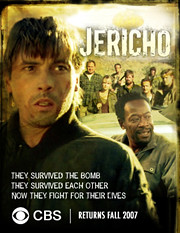Since reversing its decision to cancel Jericho, CBS has entered into a developing partnership of sorts with fans. The network released the summer rebroadcast schedule for them to promote (9 p.m. Friday, July 6), requested input on the Jericho boards (hint to CBS: see NBC's Heroes), and engaged some fans with direct participation.
Keep in mind, it has only been 10 days since Jericho was resurrected (even though it feels much, much longer). How are the fans doing? Not bad. Slowly, there has been some semblance of organization, but overall, the focus seems to be on ideas (even on the CBS message boards). So, we thought it might be fun to highlight a few ideas that stand out and skip on organization for now, hoping things don’t become more fragmented.
Fan Ads. "Rubberpoultry," who has designed several ads and banners for Jericho fans, has become a central contact for promotions. He designed the ad above, which has great graphic merit despite missing a bit on the message. While the message appeals to fans, the copy would be better served if it was written for non-fans, providing a better call to action (same with the banner). Don't get me wrong though, it's among the best of the best. For a fairly comprehensive roundup of images, scroll to the bottom of this Jericho page.
Fan Radio. If anyone earned the moniker "voice of the fans," Shaun O Mac nailed it. Enough so that CBS flew him out to meet some of the stars (Skeet Ulrich, Brad Beyer, Richard Speight, and Bob Stephenson) and Carol Barbee, executive producer of Jericho. CBS filmed some of the tour; and the footage is rumored to be made into a video news release or perhaps make the DVD. On June 10, Shaun invited me as a last-minute guest on his show. It was fun, but Jericho fans will likely enjoy some earlier shows with several of the Jericho's stars and Barbee. Shaun's someone to watch, er, listen to when he talks Jericho or not.
Fan Forums. While most fans seem to use the CBS message boards as a focal point, I still think Jericho Rally Point is better suited for fan business (unless fans want CBS to usher in the fan club). NutsOnline also launched a Jericho fan forum with the best idea there to break up the forum into states, similar to an effort on Yahoo Groups.
Fan Groups. Speaking of fan groups, Lisa Lludvicek has done a solid job communicating and coordinating some efforts in Kansas, including her promotion of 11 viewing parties before the debut of the second season. The viewing parties, held at Governor’s Stumpys Grill Kansas City, are purposely not held on nights that CBS airs Jericho. They do provide fans an opportunity to meet each other, rally more viewers, and raise funds for Greensburg, which was devastated by tornadoes.
Fan Blogs. Several blogs have sprung up and JerichoOnCBS is one of my favorites. Lisa Coultrup (kystorms) has done a solid job keeping up on the news and adding some great round-ups, including: letters from producers and celebrities, and various online contact points. In many ways, she’s providing a centralized round-up that forums just can’t deliver (check out rubberpoultry's Star Wars/Jericho parody there!). Another blog, Jericho Monster, provides a broader view, which includes conversations about the Nielsens and a link to the Black Donnellys petition.
A few other ideas that deserve mention are the pursuit of the Guinness submission and the Jericho Saved site by Jeff Knoll. The latter includes a great summary of his media tour with Lennie James (that was as brilliant as the purposefully stark nut ads Knoll produced).
So, assuming the fans still have an 8-9 million viewer base to work from, they only need 3 million more viewers to have a hit show or close to the top 20. It's doable. It seems to me CBS is doing its part on several levels, making me seriously doubt those rumors that the new seven episodes were nothing but a ruse to end the war. I think CBS has decided it might as well go for a winner with Jericho. Kudos to them for doing what appears to be a 360-degree turn on how CBS sees its viewers.
That's not to say the story is all hugs and roses. Far from it. Some fragmentation, duplication of efforts, and the lack of a solid message targeting new viewers are all working against the greater effort (before it was nuts, but nuts doesn't seem like the right message anymore). It's not surprising; protests are always easier to grow than a fan base. To her credit, Schumi has done some good in delegating "idea" categories to willing volunteers. While I wish it would have been done a bit different, it's still a step in the right direction.

Keep in mind, it has only been 10 days since Jericho was resurrected (even though it feels much, much longer). How are the fans doing? Not bad. Slowly, there has been some semblance of organization, but overall, the focus seems to be on ideas (even on the CBS message boards). So, we thought it might be fun to highlight a few ideas that stand out and skip on organization for now, hoping things don’t become more fragmented.
Fan Ads. "Rubberpoultry," who has designed several ads and banners for Jericho fans, has become a central contact for promotions. He designed the ad above, which has great graphic merit despite missing a bit on the message. While the message appeals to fans, the copy would be better served if it was written for non-fans, providing a better call to action (same with the banner). Don't get me wrong though, it's among the best of the best. For a fairly comprehensive roundup of images, scroll to the bottom of this Jericho page.
Fan Radio. If anyone earned the moniker "voice of the fans," Shaun O Mac nailed it. Enough so that CBS flew him out to meet some of the stars (Skeet Ulrich, Brad Beyer, Richard Speight, and Bob Stephenson) and Carol Barbee, executive producer of Jericho. CBS filmed some of the tour; and the footage is rumored to be made into a video news release or perhaps make the DVD. On June 10, Shaun invited me as a last-minute guest on his show. It was fun, but Jericho fans will likely enjoy some earlier shows with several of the Jericho's stars and Barbee. Shaun's someone to watch, er, listen to when he talks Jericho or not.
Fan Forums. While most fans seem to use the CBS message boards as a focal point, I still think Jericho Rally Point is better suited for fan business (unless fans want CBS to usher in the fan club). NutsOnline also launched a Jericho fan forum with the best idea there to break up the forum into states, similar to an effort on Yahoo Groups.
Fan Groups. Speaking of fan groups, Lisa Lludvicek has done a solid job communicating and coordinating some efforts in Kansas, including her promotion of 11 viewing parties before the debut of the second season. The viewing parties, held at Governor’s Stumpys Grill Kansas City, are purposely not held on nights that CBS airs Jericho. They do provide fans an opportunity to meet each other, rally more viewers, and raise funds for Greensburg, which was devastated by tornadoes.
Fan Blogs. Several blogs have sprung up and JerichoOnCBS is one of my favorites. Lisa Coultrup (kystorms) has done a solid job keeping up on the news and adding some great round-ups, including: letters from producers and celebrities, and various online contact points. In many ways, she’s providing a centralized round-up that forums just can’t deliver (check out rubberpoultry's Star Wars/Jericho parody there!). Another blog, Jericho Monster, provides a broader view, which includes conversations about the Nielsens and a link to the Black Donnellys petition.
A few other ideas that deserve mention are the pursuit of the Guinness submission and the Jericho Saved site by Jeff Knoll. The latter includes a great summary of his media tour with Lennie James (that was as brilliant as the purposefully stark nut ads Knoll produced).
So, assuming the fans still have an 8-9 million viewer base to work from, they only need 3 million more viewers to have a hit show or close to the top 20. It's doable. It seems to me CBS is doing its part on several levels, making me seriously doubt those rumors that the new seven episodes were nothing but a ruse to end the war. I think CBS has decided it might as well go for a winner with Jericho. Kudos to them for doing what appears to be a 360-degree turn on how CBS sees its viewers.
That's not to say the story is all hugs and roses. Far from it. Some fragmentation, duplication of efforts, and the lack of a solid message targeting new viewers are all working against the greater effort (before it was nuts, but nuts doesn't seem like the right message anymore). It's not surprising; protests are always easier to grow than a fan base. To her credit, Schumi has done some good in delegating "idea" categories to willing volunteers. While I wish it would have been done a bit different, it's still a step in the right direction.



















